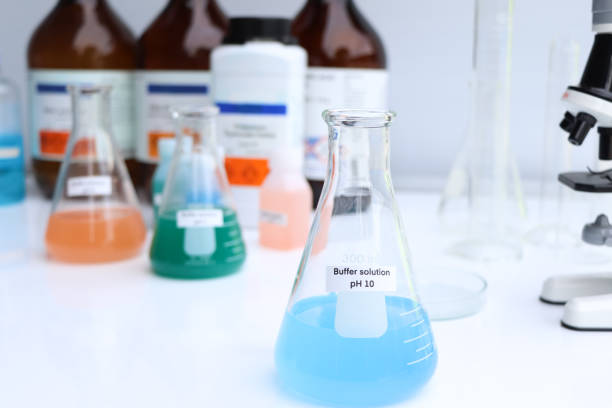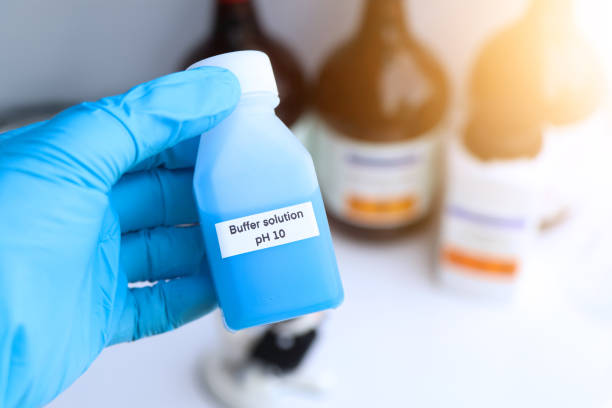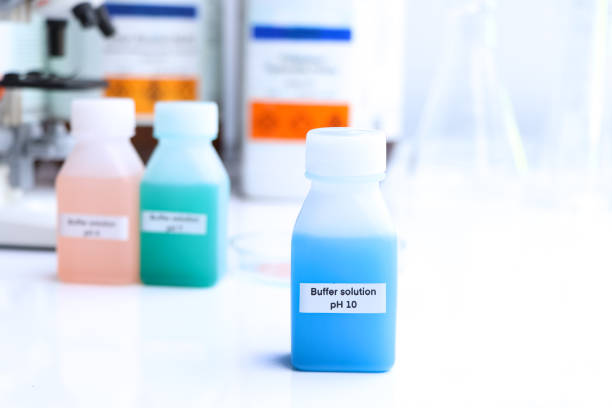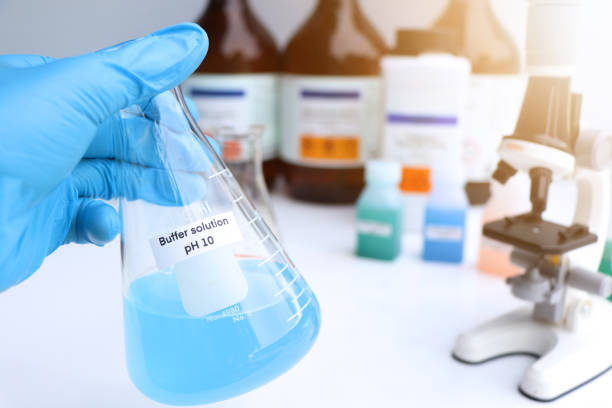In the realm of chemical analysis and biochemical research, maintaining a stable pH environment is critical. Among the wide range of buffer solutions available, the pH 10 buffer solution holds a unique place for applications requiring mildly alkaline conditions. This comprehensive guide delves into the composition, preparation, applications, and significance of pH 10 buffer solutions, providing an authoritative resource for researchers, students, and professionals alike.
Introduction to pH 10 Buffer Solution
A pH 10 buffer solution is a carefully prepared aqueous mixture that helps maintain a stable pH of around 10, even when small quantities of acids or bases are introduced. As a mildly alkaline solution, it plays a crucial role in experiments and procedures that require a consistent pH environment to achieve precise and repeatable outcomes.
The buffer capacity of a pH 10 buffer comes from the presence of a conjugate acid-base pair that operates effectively at this pH range, neutralizing added H⁺ or OH⁻ ions. This equilibrium helps maintain a stable chemical environment, even under fluctuating conditions.
Chemical Composition of pH 10 Buffer Solutions
To achieve a buffer at pH 10, the solution typically includes weak bases and their conjugate acids. Commonly used buffer systems around pH 10 include:
- Sodium carbonate (Na2CO3) and sodium bicarbonate (NaHCO3)
- Sodium borate (borax, Na2B4O7·10H2O) and boric acid (H3BO3)
- Ammonium hydroxide (NH4OH) and ammonium chloride (NH4Cl)
Among these, the carbonate/bicarbonate buffer and the borate buffer are most prevalent.
Carbonate/Bicarbonate Buffer
This system relies on the equilibrium between carbonate ions (CO3²⁻) and bicarbonate ions (HCO3⁻). The relevant equilibrium can be represented as:
CO3²⁻ + H2O ⇌ HCO3⁻ + OH⁻
This system efficiently buffers solutions in the pH range of 9.2 to 10.8, making it ideal for pH 10.
Borate Buffer
Borate buffers utilize boric acid and borate ions. The dissociation is:
B(OH)3 + H2O ⇌ B(OH)4⁻ + H⁺
At pH 10, borate ions dominate, offering excellent buffering capacity with minimal ionic strength, which is valuable for some biological assays.
How to Prepare a pH 10 Buffer Solution

Materials Needed
- Sodium carbonate (Na2CO3)
- Sodium bicarbonate (NaHCO3)
- Distilled water
- pH meter or pH indicator strips
- Volumetric flask
- Stirring rod or magnetic stirrer
Step-by-Step Preparation
- Calculate the required amounts of sodium carbonate and sodium bicarbonate based on the Henderson-Hasselbalch equation:
- pH=pKa+log([Base][Acid])
- For the carbonate system, the relevant pKapK_a is approximately 10.33.
- Dissolve the calculated masses of sodium carbonate and sodium bicarbonate in a small volume of distilled water.
- Transfer the solution to a volumetric flask and dilute to the desired final volume with distilled water.
- Mix thoroughly using a magnetic stirrer.
- Check the pH using a calibrated pH meter. Adjust if necessary by adding small amounts of sodium carbonate (to increase pH) or sodium bicarbonate (to decrease pH).
- Store the buffer solution in a clean, tightly sealed container to avoid CO2 absorption from the air, which can alter pH.
Properties and Characteristics of pH 10 Buffer Solutions

- Stable Alkaline Environment: Maintains pH near 10 even upon addition of small quantities of acids or bases.
- Good Buffer Capacity: Especially when prepared at adequate molarity (usually 0.05–0.1 M).
- Minimal Interference: Particularly with borate buffers, which have low ionic strength and do not complex with many metal ions.
- Temperature Sensitivity: pH can vary with temperature, so buffers must be calibrated or adjusted if used under varying thermal conditions.
- CO2 Sensitivity: Carbonate buffers can absorb atmospheric CO2, forming carbonic acid and lowering the pH over time, requiring fresh preparation or sealed storage.
Applications of pH 10 Buffer Solutions
The pH 10 buffer solution is widely used across various scientific disciplines due to its mildly alkaline nature:
1. Biochemical and Molecular Biology Research
Many enzymes and biochemical reactions exhibit optimal activity near pH 10. For example, alkaline phosphatase assays require this environment for accurate results. Maintaining this pH ensures enzyme stability and consistent catalytic performance.
2. Analytical Chemistry
In spectrophotometric measurements, pH 10 buffers provide a stable medium for chromogenic reactions. They are crucial in colorimetric assays and titrations involving weak acids or bases.
3. Pharmaceutical Industry
Drug formulations often require pH-controlled environments for stability testing and dissolution studies. The pH 10 buffer mimics certain physiological or formulation conditions where a basic pH is necessary.
4. Environmental Science
pH 10 buffers are used in testing water samples and soils where alkaline conditions are present, enabling precise measurement of contaminants or nutrient levels.
5. Industrial Applications
Used in cosmetics, detergents, and cleaning agent formulations, pH 10 buffers help maintain product stability and performance over time.
Advantages of Using pH 10 Buffer Solutions

- Consistency: Enables reproducibility of experiments and industrial processes.
- Ease of Preparation: Materials are readily available and cost-effective.
- Compatibility: Suitable for a wide range of chemical and biological systems.
- Wide Buffer Range: Effective buffering action over a pH range from about 9 to 11.
Common Challenges and Troubleshooting
pH Drift Over Time
Due to CO2 absorption, carbonate buffers can drift towards acidity. To minimize this:
- Use sealed containers for storage.
- Prepare buffers freshly for critical experiments.
- Consider borate buffers if CO2 contamination is problematic.
Temperature Effects
Buffer pH changes with temperature fluctuations. Always:
- Calibrate pH meters at the working temperature.
- Adjust buffer compositions if working outside the room temperature.
Ionic Strength Considerations
High ionic strength buffers may interfere with sensitive biochemical assays. Dilution or alternative buffer systems may be necessary.
Summary
The pH 10 buffer solution is an essential tool in laboratories and industries requiring a stable alkaline environment. Understanding its chemical basis, preparation, and applications is crucial for achieving reliable and accurate outcomes in diverse fields such as biochemistry, environmental science, pharmaceuticals, and industrial formulations. By carefully preparing and maintaining these buffers, researchers ensure the integrity and reproducibility of their work.
How do you make a pH 10 buffer solution?
In the realm of chemical analysis and biochemical research, maintaining a stable pH environment is critical. Among the wide range of buffer solutions available, the pH 10 buffer solution holds a unique place for applications requiring mildly alkaline conditions. This comprehensive guide delves into the composition, preparation, applications, and significance of pH 10 buffer solutions, providing an authoritative resource for researchers, students, and professionals alike.
What is a pH 10 Buffer Solution?
A pH 10 buffer solution is a carefully prepared aqueous mixture that helps maintain a stable pH of around 10, even when small quantities of acids or bases are introduced. As a mildly alkaline solution, it plays a crucial role in experiments and procedures that require a consistent pH environment to achieve precise and repeatable outcomes.
The buffer capacity of a pH 10 buffer comes from the presence of a conjugate acid-base pair that operates effectively at this pH range, neutralizing added H⁺ or OH⁻ ions. This equilibrium helps maintain a stable chemical environment, even under fluctuating conditions.
Chemical Composition of pH 10 Buffer Solutions
To achieve a buffer at pH 10, the solution typically includes weak bases and their conjugate acids. Commonly used buffer systems around pH 10 include:
Sodium carbonate (Na2CO3) and sodium bicarbonate (NaHCO3)
Sodium borate (borax, Na2B4O7·10H2O) and boric acid (H3BO3)
Ammonium hydroxide (NH4OH) and ammonium chloride (NH4Cl)
Among these, the carbonate/bicarbonate buffer and the borate buffer are most prevalent.
Carbonate/Bicarbonate Buffer
This system relies on the equilibrium between carbonate ions (CO3²⁻) and bicarbonate ions (HCO3⁻). The relevant equilibrium can be represented as:
CO3²⁻ + H2O ⇌ HCO3⁻ + OH⁻
This system efficiently buffers solutions in the pH range of 9.2 to 10.8, making it ideal for pH 10.
Borate Buffer
Borate buffers utilize boric acid and borate ions. The dissociation is:
B(OH)3 + H2O ⇌ B(OH)4⁻ + H⁺
At pH 10, borate ions dominate, offering excellent buffering capacity with minimal ionic strength, which is valuable for some biological assays.
How to Prepare a pH 10 Buffer Solution
Materials Needed
Sodium carbonate (Na2CO3)
Sodium bicarbonate (NaHCO3)
Distilled water
pH meter or pH indicator strips
Volumetric flask
Stirring rod or magnetic stirrer
Step-by-Step Preparation
Calculate the required amounts of sodium carbonate and sodium bicarbonate based on the Henderson-Hasselbalch equation:
pH=pKa+log([Base][Acid])
For the carbonate system, the relevant pKapK_a is approximately 10.33.
Dissolve the calculated masses of sodium carbonate and sodium bicarbonate in a small volume of distilled water.
Transfer the solution to a volumetric flask and dilute to the desired final volume with distilled water.
Mix thoroughly using a magnetic stirrer.
Check the pH using a calibrated pH meter. Adjust if necessary by adding small amounts of sodium carbonate (to increase pH) or sodium bicarbonate (to decrease pH).
Store the buffer solution in a clean, tightly sealed container to avoid CO2 absorption from the air, which can alter pH.
Properties and Characteristics of pH 10 Buffer Solutions
Stable Alkaline Environment: Maintains pH near 10 even upon addition of small quantities of acids or bases.
Good Buffer Capacity: Especially when prepared at adequate molarity (usually 0.05–0.1 M).
Minimal Interference: Particularly with borate buffers, which have low ionic strength and do not complex with many metal ions.
Temperature Sensitivity: pH can vary with temperature, so buffers must be calibrated or adjusted if used under varying thermal conditions.
CO2 Sensitivity: Carbonate buffers can absorb atmospheric CO2, forming carbonic acid and lowering the pH over time, requiring fresh preparation or sealed storage.
Applications of pH 10 Buffer Solutions
The pH 10 buffer solution is widely used across various scientific disciplines due to its mildly alkaline nature:
1. Biochemical and Molecular Biology Research
Many enzymes and biochemical reactions exhibit optimal activity near pH 10. For example, alkaline phosphatase assays require this environment for accurate results. Maintaining this pH ensures enzyme stability and consistent catalytic performance.
2. Analytical Chemistry
In spectrophotometric measurements, pH 10 buffers provide a stable medium for chromogenic reactions. They are crucial in colorimetric assays and titrations involving weak acids or bases.
3. Pharmaceutical Industry
Drug formulations often require pH-controlled environments for stability testing and dissolution studies. The pH 10 buffer mimics certain physiological or formulation conditions where a basic pH is necessary.
4. Environmental Science
pH 10 buffers are used in testing water samples and soils where alkaline conditions are present, enabling precise measurement of contaminants or nutrient levels.
5. Industrial Applications
Used in cosmetics, detergents, and cleaning agents formulations, pH 10 buffers help maintain product stability and performance over time.
Advantages of Using pH 10 Buffer Solutions
Consistency: Enables reproducibility of experiments and industrial processes.
Ease of Preparation: Materials are readily available and cost-effective.
Compatibility: Suitable for a wide range of chemical and biological systems.
Wide Buffer Range: Effective buffering action over a pH range from about 9 to 11.
Common Challenges and Troubleshooting
pH Drift Over Time
Due to CO2 absorption, carbonate buffers can drift towards acidity. To minimize this:
Use sealed containers for storage.
Prepare buffers freshly for critical experiments.
Consider borate buffers if CO2 contamination is problematic.
Temperature Effects
Buffer pH changes with temperature fluctuations. Always:
Calibrate pH meters at the working temperature.
Adjust buffer compositions if working outside the room temperature.
Ionic Strength Considerations
High ionic strength buffers may interfere with sensitive biochemical assays. Dilution or alternative buffer systems may be necessary.
Summary
The pH 10 buffer solution is an essential tool in laboratories and industries requiring a stable alkaline environment. Understanding its chemical basis, preparation, and applications is crucial for achieving reliable and accurate outcomes in diverse fields such as biochemistry, environmental science, pharmaceuticals, and industrial formulations. By carefully preparing and maintaining these buffers, researchers ensure the integrity and reproducibility of their work.
How to prepare a buffer solution of pH 10?
In the realm of chemical analysis and biochemical research, maintaining a stable pH environment is critical. Among the wide range of buffer solutions available, the pH 10 buffer solution holds a unique place for applications requiring mildly alkaline conditions. This comprehensive guide delves into the composition, preparation, applications, and significance of pH 10 buffer solutions, providing an authoritative resource for researchers, students, and professionals alike.
What is a pH 10 Buffer Solution?
A pH 10 buffer solution is a carefully prepared aqueous mixture that helps maintain a stable pH of around 10, even when small quantities of acids or bases are introduced. As a mildly alkaline solution, it plays a crucial role in experiments and procedures that require a consistent pH environment to achieve precise and repeatable outcomes.
The buffer capacity of a pH 10 buffer comes from the presence of a conjugate acid-base pair that operates effectively at this pH range, neutralizing added H⁺ or OH⁻ ions. This equilibrium helps maintain a stable chemical environment, even under fluctuating conditions.
Chemical Composition of pH 10 Buffer Solutions
To achieve a buffer at pH 10, the solution typically includes weak bases and their conjugate acids. Commonly used buffer systems around pH 10 include:
Sodium carbonate (Na2CO3) and sodium bicarbonate (NaHCO3)
Sodium borate (borax, Na2B4O7·10H2O) and boric acid (H3BO3)
Ammonium hydroxide (NH4OH) and ammonium chloride (NH4Cl)
Among these, the carbonate/bicarbonate buffer and the borate buffer are most prevalent.
Carbonate/Bicarbonate Buffer
This system relies on the equilibrium between carbonate ions (CO3²⁻) and bicarbonate ions (HCO3⁻). The relevant equilibrium can be represented as:
CO3²⁻ + H2O ⇌ HCO3⁻ + OH⁻
This system efficiently buffers solutions in the pH range of 9.2 to 10.8, making it ideal for pH 10.
Borate Buffer
Borate buffers utilize boric acid and borate ions. The dissociation is:
B(OH)3 + H2O ⇌ B(OH)4⁻ + H⁺
At pH 10, borate ions dominate, offering excellent buffering capacity with minimal ionic strength, which is valuable for some biological assays.
How to Prepare a pH 10 Buffer Solution
Materials Needed
Sodium carbonate (Na2CO3)
Sodium bicarbonate (NaHCO3)
Distilled water
pH meter or pH indicator strips
Volumetric flask
Stirring rod or magnetic stirrer
Step-by-Step Preparation
Calculate the required amounts of sodium carbonate and sodium bicarbonate based on the Henderson-Hasselbalch equation:
pH=pKa+log([Base][Acid])
For the carbonate system, the relevant pKapK_a is approximately 10.33.
Dissolve the calculated masses of sodium carbonate and sodium bicarbonate in a small volume of distilled water.
Transfer the solution to a volumetric flask and dilute to the desired final volume with distilled water.
Mix thoroughly using a magnetic stirrer.
Check the pH using a calibrated pH meter. Adjust if necessary by adding small amounts of sodium carbonate (to increase pH) or sodium bicarbonate (to decrease pH).
Store the buffer solution in a clean, tightly sealed container to avoid CO2 absorption from the air, which can alter pH.
Properties and Characteristics of pH 10 Buffer Solutions
Stable Alkaline Environment: Maintains pH near 10 even upon addition of small quantities of acids or bases.
Good Buffer Capacity: Especially when prepared at adequate molarity (usually 0.05–0.1 M).
Minimal Interference: Particularly with borate buffers, which have low ionic strength and do not complex with many metal ions.
Temperature Sensitivity: pH can vary with temperature, so buffers must be calibrated or adjusted if used under varying thermal conditions.
CO2 Sensitivity: Carbonate buffers can absorb atmospheric CO2, forming carbonic acid and lowering the pH over time, requiring fresh preparation or sealed storage.
Applications of pH 10 Buffer Solutions
The pH 10 buffer solution is widely used across various scientific disciplines due to its mildly alkaline nature:
1. Biochemical and Molecular Biology Research
Many enzymes and biochemical reactions exhibit optimal activity near pH 10. For example, alkaline phosphatase assays require this environment for accurate results. Maintaining this pH ensures enzyme stability and consistent catalytic performance.
2. Analytical Chemistry
In spectrophotometric measurements, pH 10 buffers provide a stable medium for chromogenic reactions. They are crucial in colorimetric assays and titrations involving weak acids or bases.
3. Pharmaceutical Industry
Drug formulations often require pH-controlled environments for stability testing and dissolution studies. The pH 10 buffer mimics certain physiological or formulation conditions where a basic pH is necessary.
4. Environmental Science
pH 10 buffers are used in testing water samples and soils where alkaline conditions are present, enabling precise measurement of contaminants or nutrient levels.
5. Industrial Applications
Used in cosmetics, detergents, and cleaning agents formulations, pH 10 buffers help maintain product stability and performance over time.
Advantages of Using pH 10 Buffer Solutions
Consistency: Enables reproducibility of experiments and industrial processes.
Ease of Preparation: Materials are readily available and cost-effective.
Compatibility: Suitable for a wide range of chemical and biological systems.
Wide Buffer Range: Effective buffering action over a pH range from about 9 to 11.
Common Challenges and Troubleshooting
pH Drift Over Time
Due to CO2 absorption, carbonate buffers can drift towards acidity. To minimize this:
Use sealed containers for storage.
Prepare buffers freshly for critical experiments.
Consider borate buffers if CO2 contamination is problematic.
Temperature Effects
Buffer pH changes with temperature fluctuations. Always:
Calibrate pH meters at the working temperature.
Adjust buffer compositions if working outside the room temperature.
Ionic Strength Considerations
High ionic strength buffers may interfere with sensitive biochemical assays. Dilution or alternative buffer systems may be necessary.
Summary
The pH 10 buffer solution is an essential tool in laboratories and industries requiring a stable alkaline environment. Understanding its chemical basis, preparation, and applications is crucial for achieving reliable and accurate outcomes in diverse fields such as biochemistry, environmental science, pharmaceuticals, and industrial formulations. By carefully preparing and maintaining these buffers, researchers ensure the integrity and reproducibility of their work.
What are the applications of pH 10 Buffer Solutions?
The pH 10 buffer solution is widely used across various scientific disciplines due to its mildly alkaline nature:
1. Biochemical and Molecular Biology Research
Many enzymes and biochemical reactions exhibit optimal activity near pH 10. For example, alkaline phosphatase assays require this environment for accurate results. Maintaining this pH ensures enzyme stability and consistent catalytic performance.
2. Analytical Chemistry
In spectrophotometric measurements, pH 10 buffers provide a stable medium for chromogenic reactions. They are crucial in colorimetric assays and titrations involving weak acids or bases.
3. Pharmaceutical Industry
Drug formulations often require pH-controlled environments for stability testing and dissolution studies. The pH 10 buffer mimics certain physiological or formulation conditions where a basic pH is necessary.
4. Environmental Science
pH 10 buffers are used in testing water samples and soils where alkaline conditions are present, enabling precise measurement of contaminants or nutrient levels.
5. Industrial Applications
Used in cosmetics, detergents, and cleaning agents formulations, pH 10 buffers help maintain product stability and performance over time.
